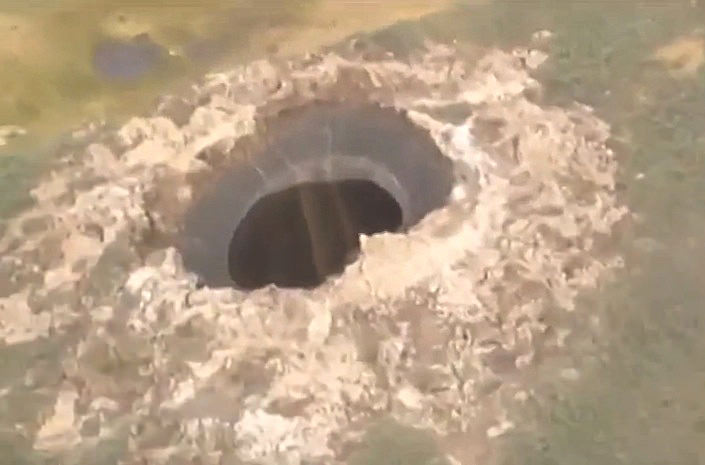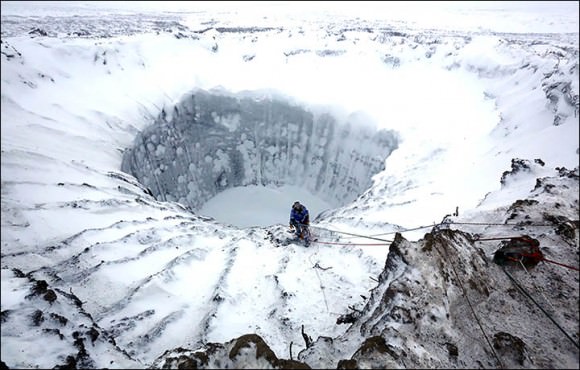What is it with Russia and explosive events of cosmic origins? The 1908
Tunguska Explosion
, the
Chelyabinsk
bolide of February 2013, and now this: an enormous
80-meter
60-meter wide crater discovered in the Yamal peninsula in northern Siberia!
To be fair, this crater is not currently thought to be from a meteorite impact but rather an eruption from below, possibly the result of a rapid release of gas trapped in what was once frozen permafrost. The Yamal region is rich in oil and natural gas, and the crater is located 30 km away from its largest gas field. Still, a team of researchers are en route to investigate the mysterious hole further.
Watch a video captured by engineer
Konstantin Nikolaev during
a helicopter flyover below:
In the video the Yamal crater/hole has what appear to be streams of dry material falling into it. Its depth has not yet been determined. (
Update:
latest measurements estimate the depth of the hole to be 50-70 meters.
Source.
)
Bill Chappell writes
on NPR's "The Two-Way":
Dark material around the inner edge of the hole seems to suggest high temperatures during its formation. But rather than the remains of a violent impact by a space rock -- or the crash-landing of a UFO, as some have already speculated -- this crater may be a particularly explosive result of global warming.
According to
The Siberian Times
:
The crater is thought to have formed sometime in 2012.
Read more at
The Siberian Times
and
NPR
.
UPDATE July 17:
A new video (in Russian) of the hole from the research team has come out, and apparently it's been made clear that it's not the result of a meteorite. Exactly what process
did
produce it is still unknown, but rising temperatures are
still thought
to be a factor. Watch below (via
Sploid
).
(If any Russian-speaking UT readers would like to translate what's being said, feel free to share in the comments below.)
Also check out the latest photos from the research expedition
at *The Siberian Times* here.
UPDATE Nov. 13:
Once the water in these holes froze solid scientists were able to enter and explore the bottoms. According to an article published on
The Guardian,
"eighty percent of the crater appears to be made up of ice and there are no traces of a meteorite strike."
[caption id="attachment_116264" align="aligncenter" width="580"]
Researchers descend into an ice-covered Yamal Crater in Siberia. Credit: Vladimir Pushkarev/Russian Centre of Arctic Exploration (via Siberian Times)[/caption]
– Vladimir Pushkarev, Director, Russian Center of Arctic Exploration
See more photos from inside the crater from the Russian Center of Arctic Exploration
on The Siberian Times here.
 Universe Today
Universe Today

